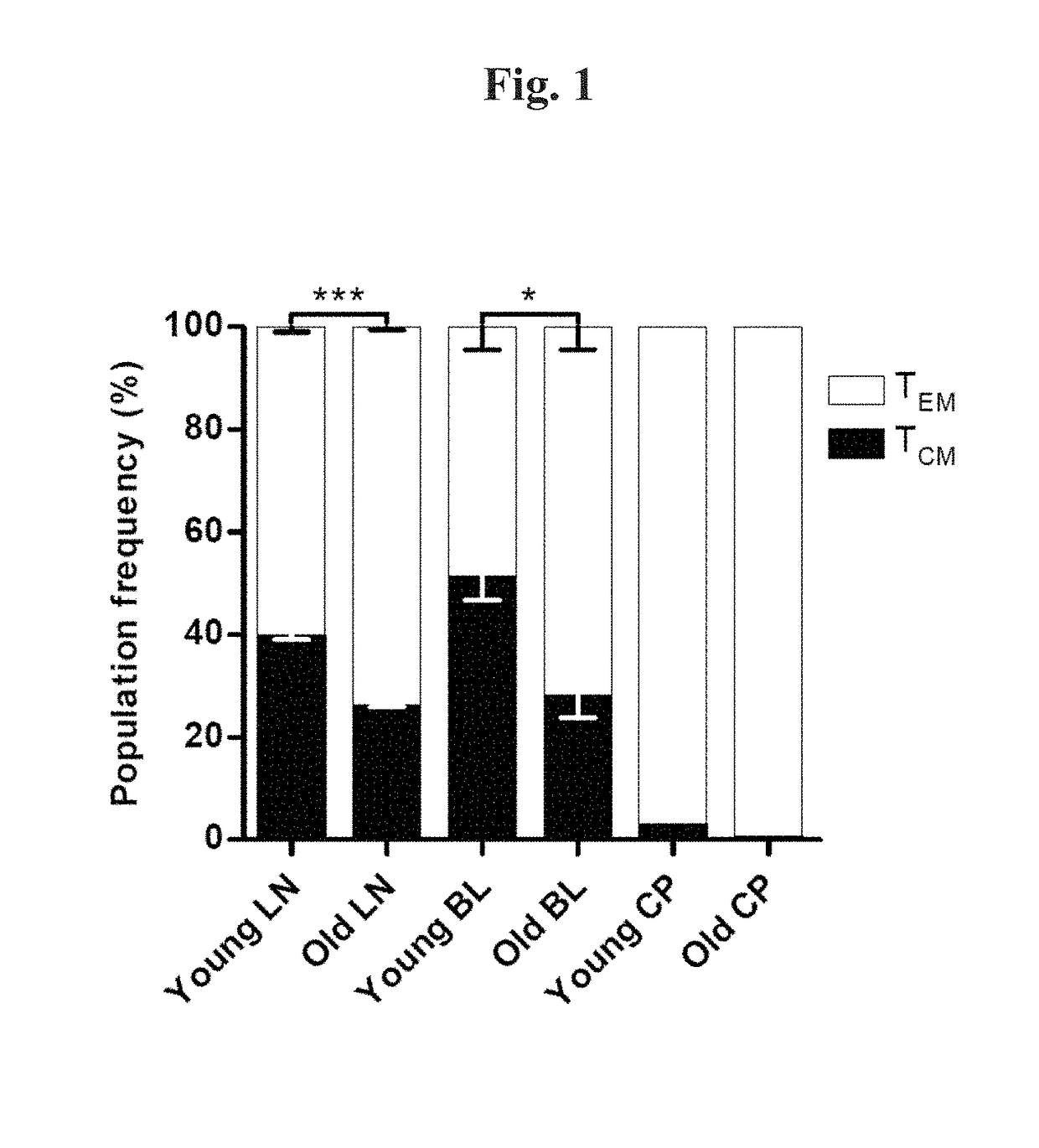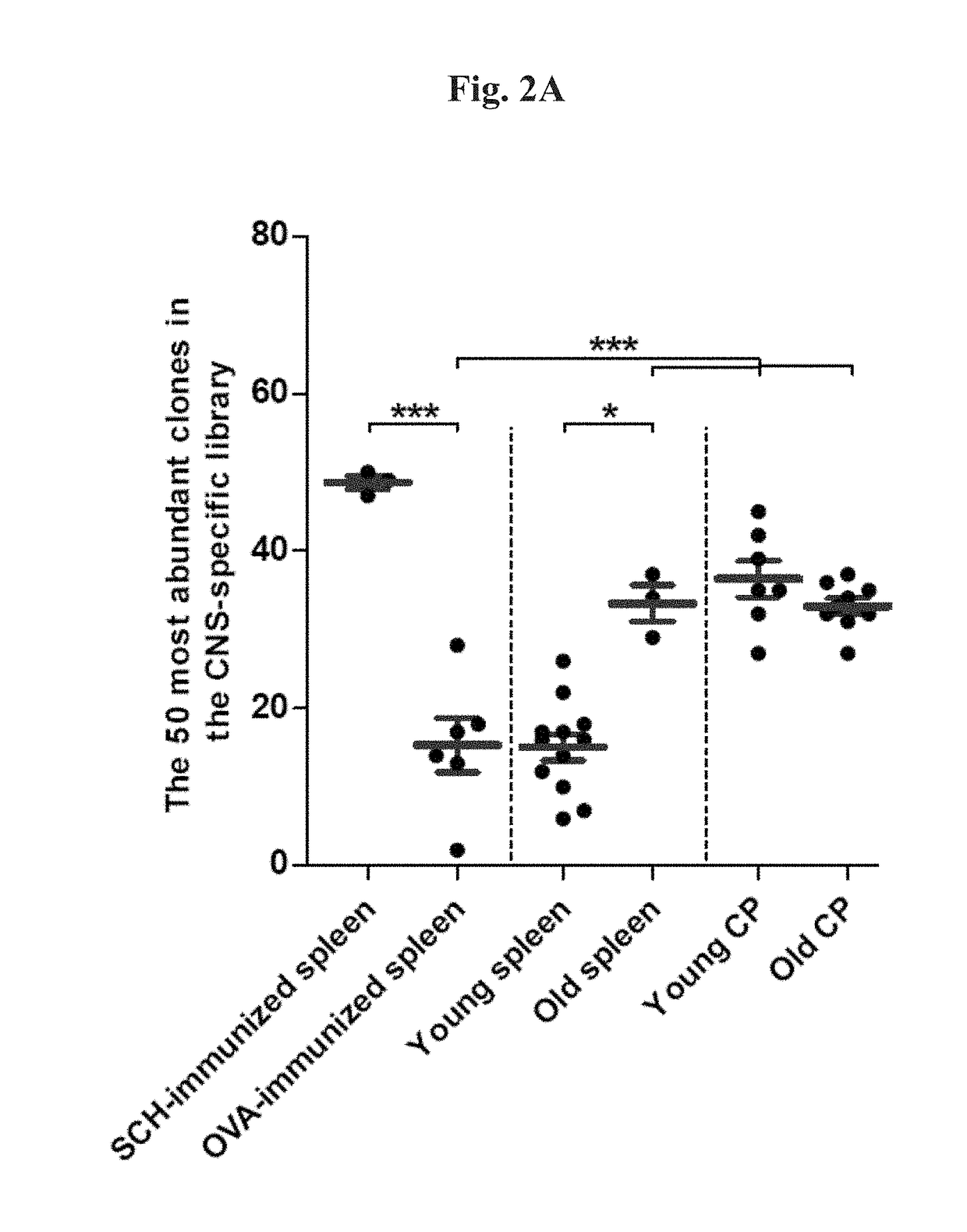Individualized Immunomodulation Therapy for Neurodegenerative Disorders, CNS Injury and Age-Related Dementia
a neurodegenerative disorder and immunomodulation therapy technology, applied in the field of neurodegenerative disorders, cns injury and age-related dementia, can solve the problems of insufficient improvement, general unsatisfactory treatment methods of cns disease, etc., and achieve the effect of reducing immunosuppression
- Summary
- Abstract
- Description
- Claims
- Application Information
AI Technical Summary
Benefits of technology
Problems solved by technology
Method used
Image
Examples
example 3
ted Inflammation of the CP Epithelium During the Aging Process
[0160]Our demonstration that the overall TCR specificity of the CD4+ T cells residing in the CP is maintained with age, led us to consider the possibility that aging of the CP may be associated not with changes in immune specificity, but rather with phenotype bias, such as changes in the cytokine milieu, a phenomenon established outside the CNS (Alberti S, et al. (2006); Shearer G M (1997); Rink L et al. (1998)). We therefore measured mRNA expression levels of the cytokines IFN-γ and IL-4 in the CP, representing Th1 and Th2 effector milieus, respectively. We found preferential elevation of IL-4 expression, and a decline in IFN-γ expression with aging (FIG. 3A). Outside the CNS, IL-4 was shown to induce the elevation of CCL11 (Bloemen K, et al. (2007)), a chemokine recently shown to play a part in age-related cognitive decline and to be elevated in the CSF and plasma of aged mice and humans (Villeda S A, et al. (2011)). Ac...
example 4
f Syngeneic Homeostatic-Driven Proliferation on the CP and Hippocampus
[0163]The increased levels of IL-4 in the CP of aged mice without proper balance by IFN-γ could reflect the well-characterized alternations in circulating immune cells during aging (Alberti S, et al. (2006); Shearer G M (1997); Rink L, et al. (1998)). One way by which immunesenescence can be alleviated and memory T cells can be expanded, is the induction of lymphopenia, which is followed by homeostatic-driven proliferation (HDP) of the residual T cell population. We therefore induced HDP by irradiation of the peripheral organs while shielding the head. Since we used high-dose irradiation and aimed to induce homeostatic-driven proliferation of memory T cells that already exist in the aged mice, the hematopoietic cell lineages were restored with syngeneic (pseudo-autologous) bone marrow (BM) derived from genetically identical donors of the same age. We expected that memory T cells that are present in the aged BM wou...
example 5
ization of the Naïve CP for its Resident T-Cell Populations and Epithelial Cytokine Receptors
[0166]First, we localized the T cell populations that reside in the choroid plexus under normal conditions in wild type (WT) mice. As previously reported, CD3+ T-cells are found at the stroma of the CP epithelium. Using flow cytometry, we determined the effector potential of these T cells to secrete various cytokines, in comparison with these T cells from the spleen and the circulation. Intracellular staining of the CD4+ T cell populations showed that interferon (IFN)-γ producing T helper (Th)1 cells were present in the naive CP (FIG. 6A). To quantify the population of interleukin (IL)-4 producing Th2 cells, we took advantage of mice that express green fluorescent protein (GFP) under the IL-4 promoter (Mohrs et al., 2001), and found a population of CD4+ T cells in the CP that express IL-4 (FIG. 6B). We also stained the CD4+ T cells for FoxP3, a marker for regulatory T cells (Tregs) (Hori et ...
PUM
| Property | Measurement | Unit |
|---|---|---|
| latency time | aaaaa | aaaaa |
| real time qPCR | aaaaa | aaaaa |
| real time qPCR | aaaaa | aaaaa |
Abstract
Description
Claims
Application Information
 Login to View More
Login to View More - R&D
- Intellectual Property
- Life Sciences
- Materials
- Tech Scout
- Unparalleled Data Quality
- Higher Quality Content
- 60% Fewer Hallucinations
Browse by: Latest US Patents, China's latest patents, Technical Efficacy Thesaurus, Application Domain, Technology Topic, Popular Technical Reports.
© 2025 PatSnap. All rights reserved.Legal|Privacy policy|Modern Slavery Act Transparency Statement|Sitemap|About US| Contact US: help@patsnap.com



